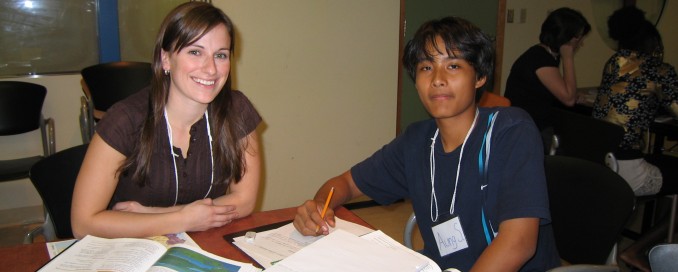Equity in Education: Strengthening Educational Achievement among Youth Living in Low-Income Neighbourhoods in Ottawa
October 3, 2017In November 2015, a meeting was convened with representatives of the Ottawa Local Immigration Partnership (OLIP), the Ottawa Child and Youth Initiative (OCYI) and the Pinecrest Queensway Community Health Centre (host organization for Pathways to Education Ottawa), to discuss their shared vision of strengthening educational achievement and graduation rates among youth living in low-income neighbourhoods.
This meeting provided the impetus for Equity in Education, a collective impact project which brings together a wide range of partners from multiple sectors to work together with the common agenda of moving the needle forward on graduation rates among priority neighbourhoods in Ottawa.
Equity in Education began its work 18 months ago, with funding from Pathways to Education Canada and a grant from the Ontario Trillium Foundation.
“Equity in Education’s aim is to improve high school graduation rates in low income neighbourhoods across the city,” says James Thibeault, Project Manager, Equity in Education. “It does this by building on the existing strengths, capacities and assets of the youth, their families and the community. The project also hopes to fill gaps in resources and service delivery by building on the best practices used by Pathways to Education and other evidence-based models. The education of young people is the responsibility of the entire community.”
There is a greater opportunity to enact significant positive impact on graduation rates city wide if work is done collectively with many organizations and stakeholders that have a vested interest in addressing this issue. Over 30 representatives from more than 20 organizations and institutions have been brought together through five stakeholder meetings over the past 18 months, to discuss and shape the direction of this initiative. These included representatives from the four local school boards, funders, youth serving organizations, Community Health and Resource Centres, Ottawa Community Housing and alumni of the Pathways to Education program.
The hope is that through a collective impact approach, Equity in Education will be able to improve graduation rates by:
- engaging stakeholders and community members in conversations and mutually reinforcing activities that will inform program content and delivery;
- improving evaluation capacity and data utilization;
- strengthening partner and stakeholder contributions;
- facilitating knowledge and resource sharing;
- improving communication amongst stakeholders; and
- influencing policy, systems change and decision making related to resolving the issue of equity in educational attainment for students living in low income neighborhoods.
“One tangible outcome of the Equity in Education initiative is that we are currently running a small scale pilot project at the Banff Avenue and Confederation Court Community Houses,” says Mr. Thibeault. The two neighbourhoods were selected because of several factors, including current capacity and a history of strong partnerships, historic high school graduation rates, socio-economic status, percentage of newcomers and refugees, percentage of single parent families, grade six standardized testing scores and unemployment rates. The community houses are ideal for such a pilot project as they are first point of entry for many social services and are in a unique position to deliver holistic, long-term, barrier-free assistance to members of the community.
In each neighbourhood, a student support worker has been providing guidance and support to grade eight students to help them successfully transition to high school. “These student support workers become advocates for the youth and their families, liaising with the schools and connecting the students to the supports needed for long-term success,” says Mr. Thibeault. “For instance, they have been working with youth and their families to explain the difference between applied and academic streams, so that they fully understand the impact of the choices presented to them and are also aware of the supports that are available to increase their chances of success.”
This project has also quickly forged relationships with the local schools in Ottawa. “The schools have helped us with our efforts to identify and outreach to eligible students and obtain the parental consent needed to move forward,” explains Mr. Thibeault.
The project has also received funding from the Higher Education Council of Ontario to evaluate this pilot project and write a comprehensive report that will help inform the future direction of the Equity in Education initiative. This report will also enable the Equity in Education initiative to build its evaluation capacity and share knowledge with other stakeholders across the province.
Equity in Education responds to one of the key priorities of OLIP’s Education Sector Table, which is to develop neighbourhood-based plans to emulate the Pathways to Education model in low-income neighbourhoods with a high proportion of immigrant families. OLIP is part one of three core partners that are steering the initiative towards its vision.
“We at OLIP talk about opportunity gaps, which are at the core of differentials in graduation rates for many students living in low-income neighborhoods, many of whom are immigrants or children of immigrants,” says Hindia Mohamoud, Director, OLIP. “Through collective impact methodology and process, we envision that we will enable the development of complementary, best practice programs and supports that together will students’ success. The great participation of so many groups and organizations makes this initiative very promising.”


 In our city’s history, immigrants have always played an important role. They build our economic prosperity, diversify our culture, contribute to our social vitality.
In our city’s history, immigrants have always played an important role. They build our economic prosperity, diversify our culture, contribute to our social vitality.

